Interspecific Associations of Dominant Tree Species at Different Structural Levels and Community Stability in the Habitat of Endangered Plant Hopea hainanensis Merr. & Chun
Abstract
1. Introduction
2. Materials and Methods
2.1. Study Area
2.2. Plot Setup and Survey Methodology
2.3. Identification of Species
2.4. Data Processing
2.4.1. Stratification of Forest Layers and Calculation of Importance Values
2.4.2. Overall Connectivity Test
2.4.3. Interspecific Connectivity and Interspecies Correlation Analysis
2.4.4. Community Stability Analysis
2.5. Data Analysis
3. Results
3.1. The Importance Value of Dominant Tree Species in Different Structural Layers of the Community Where Hopea hainanensis Is Located
3.2. The Overall Association of Dominant Tree Species Across Different Structural Levels in the Community Where Hopea hainanensis Is Located
3.3. Interspecific Associations of Dominant Tree Species Across Different Structural Levels in the Hopea hainanensis Community
3.3.1. Interspecific Connectivity
3.3.2. Interspecific Correlation
3.4. The Community Stability of Different Structural Levels in the Community Where Hopea hainanensis Is Located
4. Discussion
4.1. The Importance Value of Dominant Tree Species at Different Structural Levels in the Community Where Hopea hainanensis Is Located
4.2. The Overall Connectivity of Dominant Tree Species Across Different Structural Levels in the Community Where Hopea hainanensis Is Located
4.3. Interspecific Associations of Dominant Tree Species Across Different Structural Layers in the Community Where Hopea hainanensis Is Present
4.4. The Stability of Different Structural Levels in the Community Where Hopea hainanensis Is Located
5. Conclusions
Author Contributions
Funding
Data Availability Statement
Conflicts of Interest
References
- Mori, A.S.; Isbell, F.; Cadotte, M.W. Assessing the importance of species and their assemblages for the biodiversitycosystem multifunctionality relationship. Ecology 2023, 104, e4104. [Google Scholar] [CrossRef]
- Akatov, V.V.; Akatova, T.V.; Chefranov, S.G. Degree of Dominance and Species Richness in Plant Communities with High and Low Intensity of Interspecies Competition. Biol. Bull. Rev. 2018, 8, 389–400. [Google Scholar] [CrossRef]
- Detto, M.; Levine, J.M.; Pacala, S.W. Maintenance of high diversity in mechanistic forest dynamics models of competition for light. Ecol. Monogr. 2022, 92, e1500. [Google Scholar] [CrossRef]
- He, R.; Xiao, B.Q.; Hu, R.; Tang, H.; We, J.; Wu, P. Niche and interspecific association of dominant zooplankton species near the Taishan coastal area in the South China Sea. Mar. Environ. Res. 2025, 204, 106929. [Google Scholar] [CrossRef]
- Yu, Y.; Luo, Y.H.; Liu, Z.Y.; Meng, J.; Huang, Y.J. Analysis of Inter-species Association and Inter-species Correlation of Dominant Trees in Evergreen and Deciduous Broad-leaved Mixed Forest in Mt. Cenwanglaoshan. Guangxi Sci. 2020, 27, 145–153. [Google Scholar]
- Deng, L.P.; Li, X.J.; Li, L.L.; Niu, S.S.; Han, M.N.; Qin, S.J.; Zhou, Y.B. Interspecific association and correlation among dominant woody plants of secondary forest in montane region of eastern Liaoning Province, China. Chin. J. Ecol. 2015, 34, 1473–1479. [Google Scholar]
- Zhou, L.L.; Zhang, Q.Q.; Zhao, Y.T.; Xu, M.S.; Chen, J.Y.; Zhu, D.N.; Song, Y.J.; Huang, H.X.; Song, Q.X.; Shi, Q.R.; et al. Species association and correlation between vertical layers in the Liquidambar formosana community in Tiantong region, Zhejiang Province. J. Plant Ecol. 2015, 39, 1136–1145. [Google Scholar]
- He, L.; Su, M.M.; Chen, D.C.; Zeng, H.; Huang, X.; Li, H.; Deng, D. Characteristics and community stabilities of the resource islands formed by Salix paraplesia shrubs in the mobile sandy land of the upper reaches of the Yellow River in Sichuan Province. Heliyon 2024, 10, e4088. [Google Scholar] [CrossRef]
- Ma, Y.X.; Wang, Y.L.; Li, G.T.; Liang, T.Y.; Zou, M.; Yan, J.Q.Z.; Ma, H. HunShanDaKe sand east edge of vegetation ecological niche and interspecific association studies. IOP Conf. Ser. Earth Environ. Sci. 2019, 351, 012045. [Google Scholar] [CrossRef]
- Han, W.H.; Li, X.K.; Ye, D.; Lu, S.H.; Xiang, W.S.; Song, T.Q.; Cao, H.L. Inter-species Association and Correlation of Populations in Evergreen and Deciduous Broad-leaved Mixed Forest in Karst Area of Northwest Guangxi. J. Mt. Sci. 2009, 27, 719–726. [Google Scholar]
- Liu, J.Y.; Zhang, J.; Zhang, F.; Zhang, H.; Wang, Z.H.; Liu, J.H.; Lu, S.J. Effects of Enclosure on Interspecific Association of Dominant Populations in Stipa breviflora Desert Steppe. Ecol. Environ. Sci. 2025, 34, 247–255. [Google Scholar]
- Cao, S.X.; Huang, Y.T.; Luo, Z.; Lin, X.T.; Chen, Y.; Zhang, Q.; Liu, X.Z.; Deng, C.Y. Niche Characteristics of Dodonaea viscosa Shrub Community and Its Influence by Environment in Fujian Islands. J. Northeast For. Univ. 2025, 53, 88–98. [Google Scholar]
- Wu, H.P.; Liu, J.; Liu, L.; Li, L. Structure and Similarity Analysis of Plant Communities at Different Altitudes in the Tropical Mountain Rainforest of Yinggeling, Hainan Province. Bot. Stud. 2024, 13, 1–14. [Google Scholar]
- Liu, H.D.; Chen, Q.; Liu, X.; Xu, Z.; Dai, Y.; Liu, Y.; Chen, Y. Variation patterns of plant composition/diversity in Dacrydium pectinatum communities and their driving factors in a biodiversity hotspot on Hainan Island, China. Glob. Ecol. Conserv. 2020, 22, e01034. [Google Scholar] [CrossRef]
- Fu, L.G. China Plant Red Data Book: Rare and Endangered Plants; Science Press: Beijing, China, 1991; Volume 1. [Google Scholar]
- Editorial Committee of Flora Reipublicae Popularis Sinicae; Chinese Academy of Sciences. Flora Reipublicae Popularis Sinicae; Science Press: Beijing, China, 1990. [Google Scholar]
- Wu, E.H.; Nong, S.Q.; Yang, X.B.; Lu, G.; Li, D.H. Hopea hainanensis: A Representative Tree Species of Hainan Tropical Rainforest. For. Humankind. 2021, 42–45. Available online: https://www.cnki.com.cn/Article/CJFDTotal-SLRL202110007.htm (accessed on 12 August 2025).
- Luo, W.; Xu, H.; Li, Y.P.; Xie, C.P.; Lu, C.Y.; Liang, C.S.; Su, H.H.; Li, Z.L. Population Structure and Quantity Dynamics of the Wild Plant Hopea hainanensis (Extremely Small Population). For. Res. 2023, 36, 169–177. [Google Scholar]
- Li, Z.; Zang, H.L.; Chen, Y.K.; Nizamani, M.M.; Zhou, Q.; Su, X. Analyses of community stability and inter-specific associations between a plant species with extremely small populations (Hopea hainanensis) and its associated species. Front. Ecol. Evol. 2022, 10, 922829. [Google Scholar] [CrossRef]
- Xu, Y.; Zang, R.G. Conservation of rare and endangered plant species in China. iScience 2023, 26, 15. [Google Scholar] [CrossRef]
- Chen, Y.K.; Zhang, H.L.; Zhang, L.; Nizamani, M.M.; Zhou, T.; Zhang, H.; Liu, T. Genetic diversity assessment of Hopea hainanensis in Hainan Island. Front. Plant Sci. 2022, 13, 1075102. [Google Scholar] [CrossRef]
- Xiao, Y.X.; Yin, L.H.; Yu, W.B.; Tang, J.W. Population Structure and Seedling Regeneration of Ex-situ Cultivated Hopea hainanensis. J. Plant Sci. 2023, 41, 604–612. [Google Scholar]
- Zhang, D.X.; Qi, X.M.; Liu, S.; Lu, K.; Chen, Y.; Long, W. Seasonal home range utilization of Hainan gibbons (Nomascus hainanus) in a secondary tropical forest of Hainan Island, South China. Glob. Ecol. Conserv. 2024, 54, e03063. [Google Scholar] [CrossRef]
- Xie, C.P.; Chen, L.; Luo, W.; Jim, C.Y. Species diversity and distribution pattern of venerable trees in tropical Jianfengling National Forest Park (Hainan, China). J. Nat. Conserv. 2024, 77, 126542. [Google Scholar] [CrossRef]
- Raven, P.; Wu, Z.Y. Flora of China; Missouri Botanical Garden; Science Press: Beijing, China, 1994. [Google Scholar]
- Yang, X.B. Flora of Hainan; Science Press: Beijing, China, 2015; Volumes 1–14. [Google Scholar]
- Wang, G.H.; Fang, J.Y.; Guo, K.; Xie, Z.Q.; Tang, Z.Y.; Shen, Z.H.; Wang, R.Q.; Wang, N.P.; Wang, D.L.; Qiang, S.; et al. Compilation Content and Specifications of Flora Vegetationis Sinicae. Chin. J. Plant Ecol. 2020, 44, 128–178. [Google Scholar] [CrossRef]
- Zhao, Y.; Qi, R.; Li, B.; Liu, T.; Cao, J.H.; Li, Y. Niche of woody plant populations in Picea purpurea community in the upper Taohe River. Ecol. Indic. 2024, 166, 112557. [Google Scholar] [CrossRef]
- Schluter, D. A Variance Test for Detecting Species Associations, with Some Example Applications. Ecology 1984, 65, 998–1005. [Google Scholar] [CrossRef]
- Liu, R.H.; Jiang, Y.; Chang, B.; Li, J.F.; Rong, C.Y.; Liang, S.C.; Yang, R.A.; Liu, X.T.; Zeng, H.F.; Su, X.L.; et al. Interspecific Association and Correlation of Main Woody Plants in Pterocarya stenoptera Community Along the Lijiang River Bank. Acta Ecol. Sin. 2018, 38, 6881–6893. [Google Scholar]
- Zhang, J.T. Quantitative Ecology, 3rd ed.; Science Press: Beijing, China, 2018. [Google Scholar]
- Jian, M.F.; Liu, Q.; Zhu, D.; You, H. Interspecific Association of Dominant Tree Populations in Evergreen Broad-leaved Forest of Jiulianshan. Chin. J. Plant Ecol. 2009, 33, 672–680. [Google Scholar]
- Zheng, Y.R. Preliminary Study on Research Methods of Forest Community Stability. Sci. Silvae Sin. 2000, 36, 28–32. [Google Scholar]
- Zhang, W.; Zhang, J.L. Analysis on Species Dominance and Dominant Species of Grassland Plant Communities in Karst Mountains. Agric. Sci. Technol. 2011, 12, 1020–1024. [Google Scholar]
- Ai, X.; Xue, W.X.; Ai, X.R.; Yao, L.; Zhu, J.; Guo, Q.J. Niche and Interspecific Association of Dominant Species in Baeckea frutescens Scrub of Mulinzi. J. For. Environ. 2024, 44, 501–510. [Google Scholar]
- Yang, Z.; Liu, X.; Zhou, M.; Ai, D.; Wang, G.; Wang, Y.; Lundholm, J.T. The effect of environmental heterogeneity on species richness depends on community position along the environmental gradient. Sci. Rep. 2015, 5, 15723. [Google Scholar] [CrossRef]
- Nan, Q.R.; Zhang, Q.; Li, X.H.; Zheng, D.; Li, Z.; Zhao, L. Niche and Interspecific Association of the Dominant Species during the Invasion of Alternanthera philoxeroides in the Yangtze River Basin, China. Agriculture 2023, 3, 621. [Google Scholar] [CrossRef]
- Zhang, Y.Y.; Zhou, W.M.; Yuan, Q.; Deng, J.; Zhou, L.; Yu, D. Niches, interspecific associations, and community stability of main understory regeneration species after understory removal in temperate forests. Front. Plant Sci. 2024, 15, 1371898. [Google Scholar] [CrossRef] [PubMed]
- Wu, D.T.; Wu, C.P.; Wei, W.X.; Jiao, J.J.; Jiang, B.; Zhu, J.R.; Yuan, W.G. Interspecific association dynamics of Nanmu natural forest in Jiande, Zhejiang Province. J. Zhejiang AF Univ. 2021, 4, 671–681. [Google Scholar]
- Luo, Y.S. Community and Phylogenetic Structure of Evergreen Secondary Forest and Its Environmental Explanation in Liankangshan National Nature Reserve. Ph.D. Thesis, Henan Agricultural University, Zhengzhou, China, 2023. [Google Scholar]
- Huang, L.J.; Yu, Y.M.; An, X.F.; Yu, L.L.; Xue, Y.G. Interspecific Association of Main Woody Plants in Tiankeng Forest of Dashiwei Tiankeng Group, Guangxi. Guihaia 2021, 41, 695–706. [Google Scholar]
- Zhang, Y.; Guo, L.P.; Yi, X.M.; Cao, W.; Wang, Y.X.; Wu, P.L.; Ji, L.Z. Interspecific Association of Main Tree Species in Three Forest Communities on the Northern Slope of Changbai Mountain. Acta Ecol. Sin. 2015, 35, 106–115. [Google Scholar]
- Li, K.J.; Cai, C.; Ruan, G.M.; Ling, S.W.; Pan, B.Z.; Zhou, J.G.; Liu, J.F.; Zheng, S.Q. Interspecific Relationships and Community Stability of Main Tree Species in Ormosia microphylla Community. Chin. J. Appl. Ecol. 2025, 36, 427–436. [Google Scholar] [CrossRef]
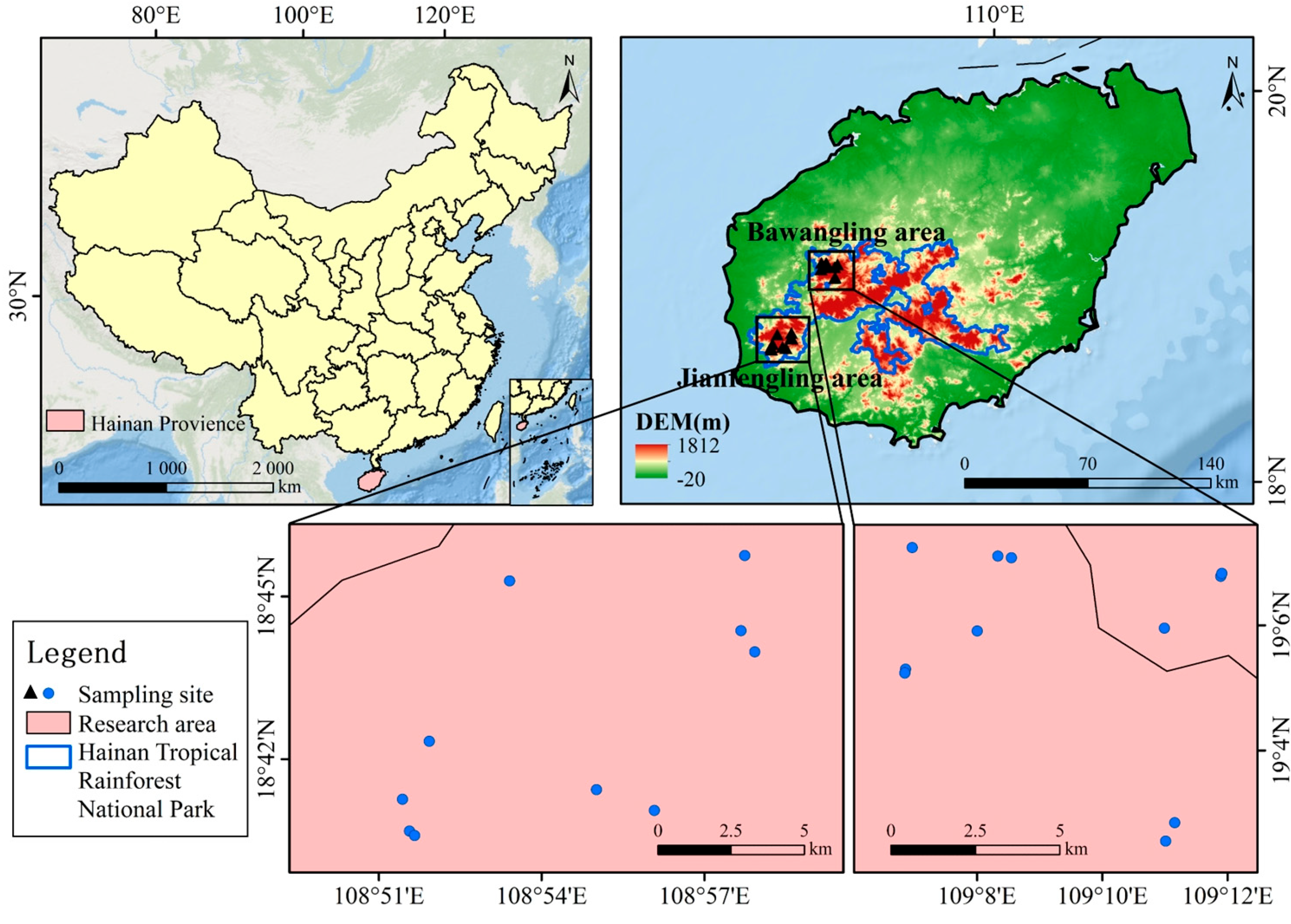
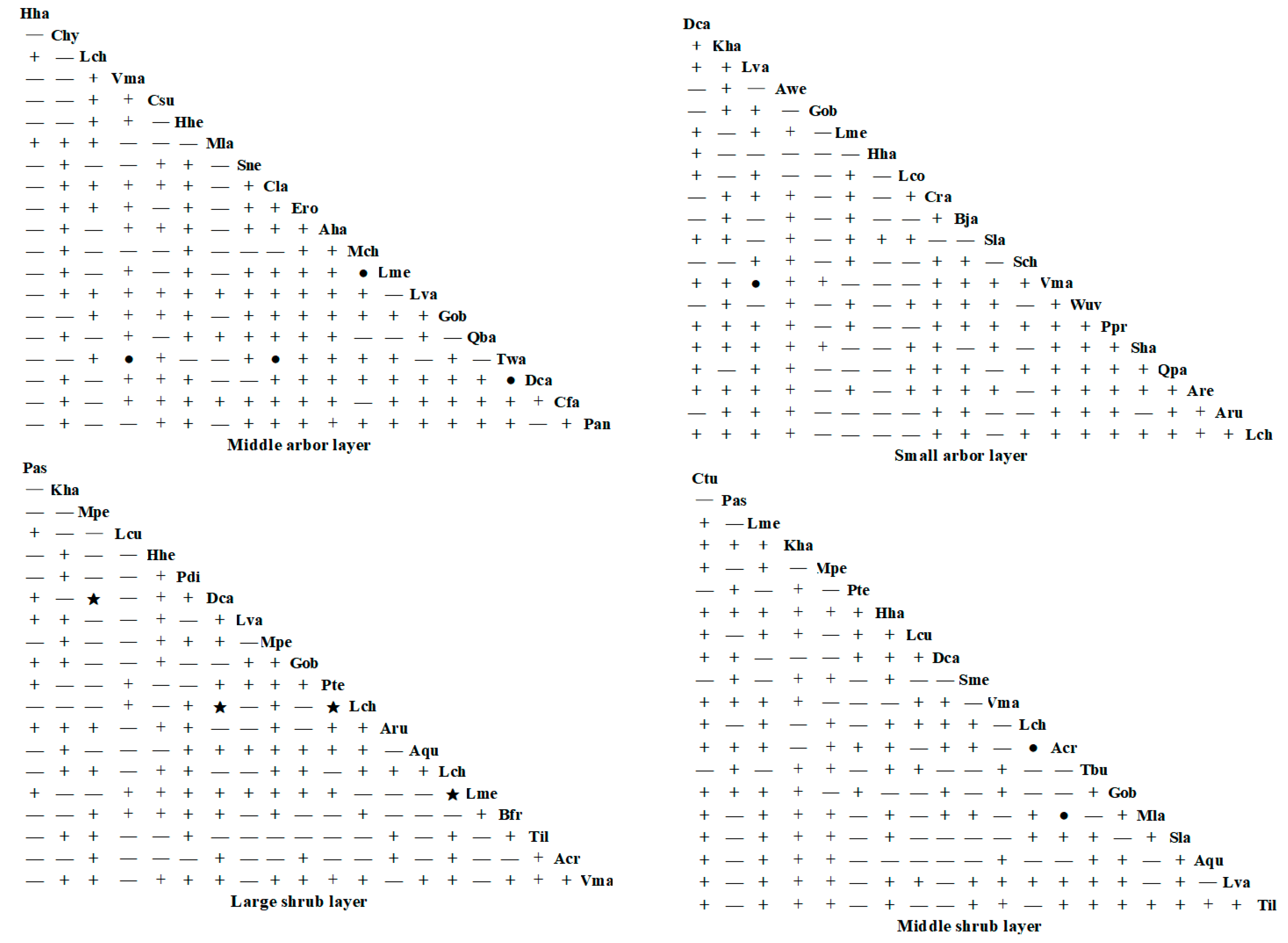
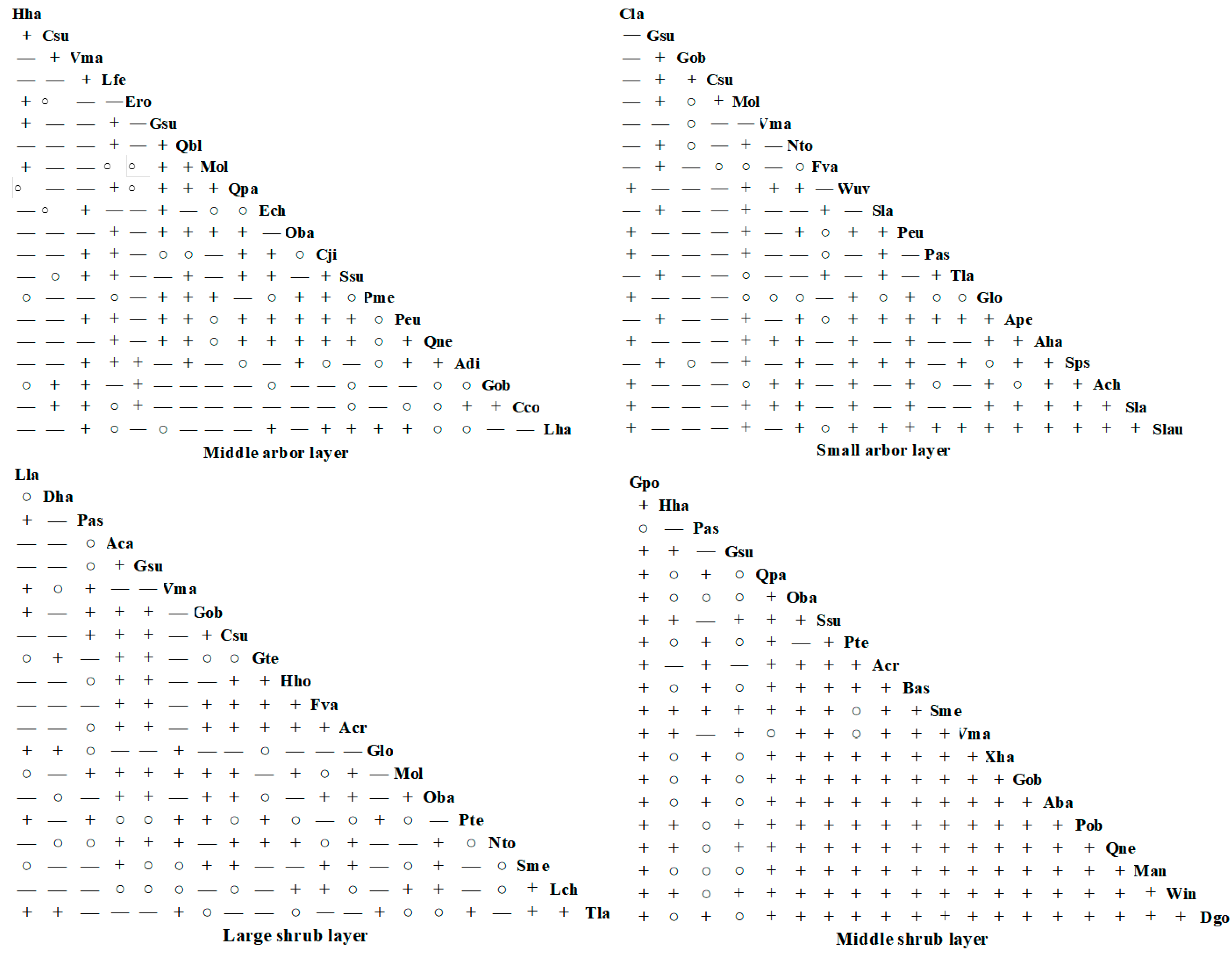

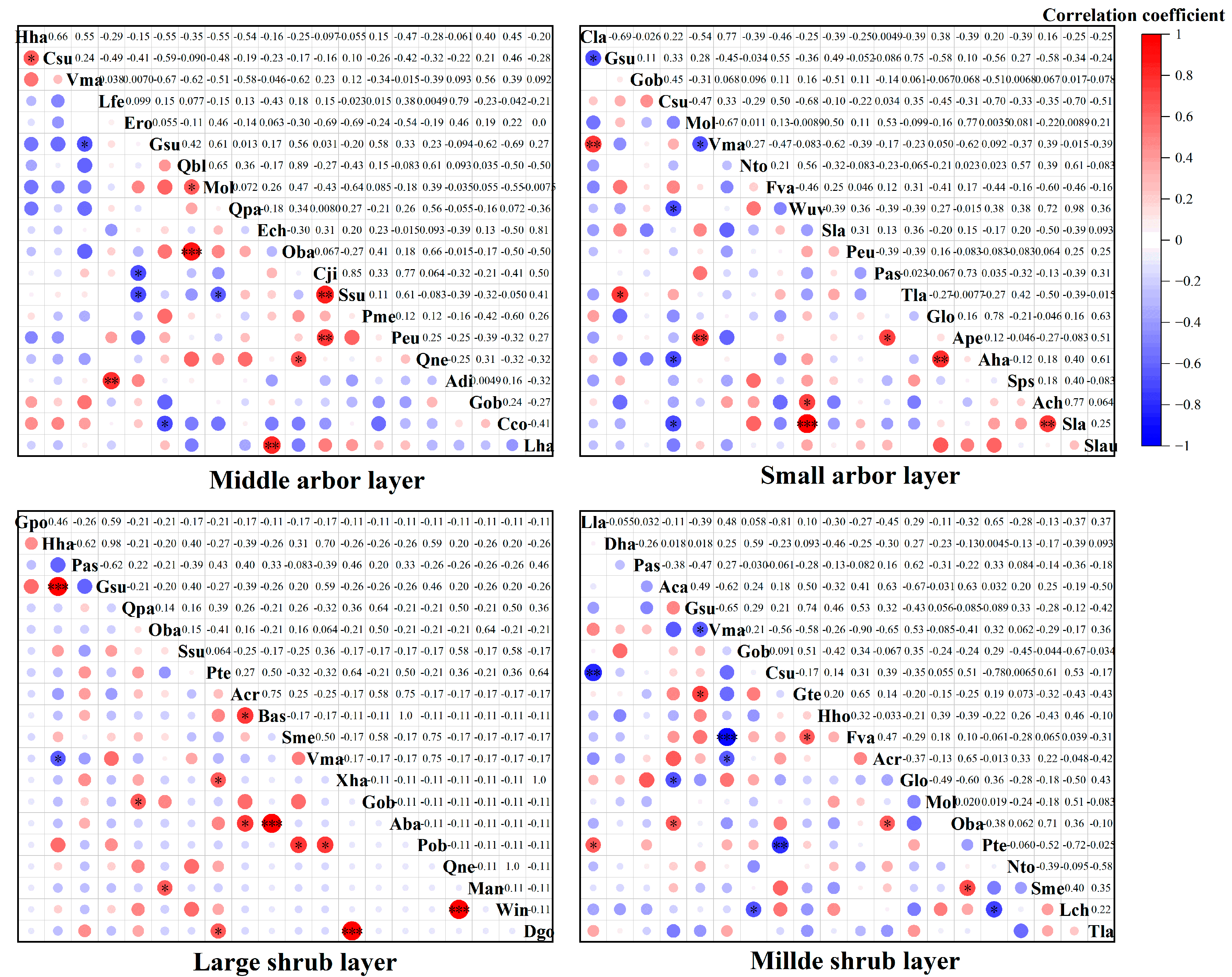
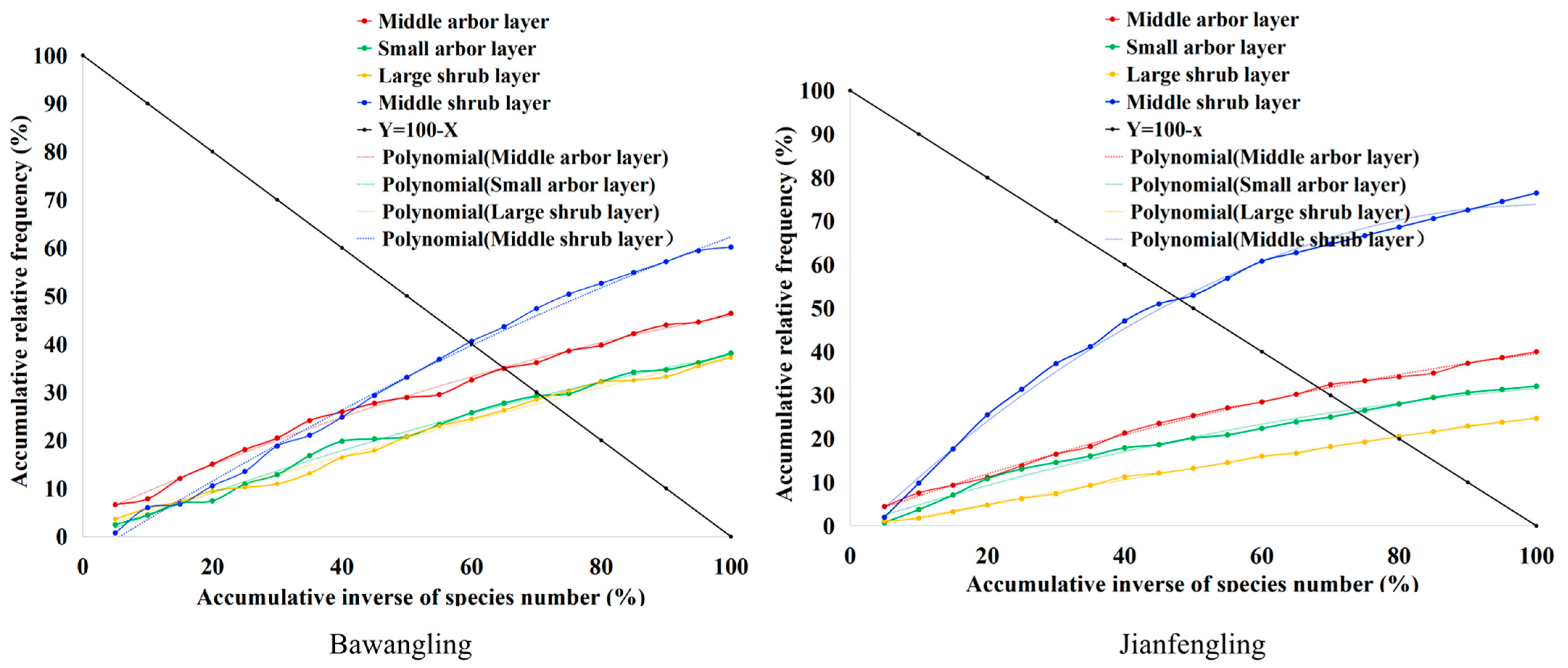
| Levels | Ranking | Latin Name | Abbreviation | Importance Value |
|---|---|---|---|---|
| Middle arbor layer | 1 | Hopea hainanensis | Hha | 12.441 |
| 2 | Castanopsis hystrix | Chy | 4.492 | |
| 3 | Litchi chinensis | Lch | 3.813 | |
| 4 | Vatica mangachapoi | Vma | 3.784 | |
| 5 | Canarium subulatum | Csu | 3.153 | |
| 6 | Heptapleurum heptaphyllum | Hhe | 2.792 | |
| 7 | Monoon laui | Mla | 2.728 | |
| 8 | Syzygium nervosum | Sne | 2.427 | |
| 9 | Croton laevigatus | Cla | 2.173 | |
| 10 | Engelhardia roxburghiana | Ero | 2.087 | |
| 11 | Adinandra hainanensis | Aha | 2.015 | |
| 12 | Machilus chinensis | Mch | 1.931 | |
| 13 | Lithocarpus megalophyllus | Lme | 1.872 | |
| 14 | Litsea variabilis | Lva | 1.841 | |
| 15 | Garcinia oblongifolia | Gob | 1.823 | |
| 16 | Toona sinensis | Tsi | 1.755 | |
| 17 | Tarennoidea wallichii | Twa | 1.744 | |
| 18 | Diospyros cathayensis | Dca | 1.737 | |
| 19 | Castanopsis faberi | Cfa | 1.716 | |
| 20 | Pouteria annamensis | Pan | 1.703 | |
| Small arbor layer | 1 | Diospyros cathayensis | Dca | 6.175 |
| 2 | Koilodepas hainanense | Kha | 4.026 | |
| 3 | Litsea variabilis | Lva | 3.788 | |
| 4 | Arenga westerhoutii | Awe | 3.747 | |
| 5 | Garcinia oblongifolia | Gob | 3.459 | |
| 6 | Lithocarpus megalophyllus | Lme | 3.040 | |
| 7 | Hopea hainanensis | Hha | 2.817 | |
| 8 | Lithocarpus corneus | Lco | 2.455 | |
| 9 | Chionanthus ramiflorus | Cra | 2.450 | |
| 10 | Bischofia javanica | Bja | 2.449 | |
| 11 | Sterculia lanceolata | Sla | 2.447 | |
| 12 | Syzygium chunianum | Sch | 2.235 | |
| 13 | Vatica mangachapoi | Vma | 1.835 | |
| 14 | Wendlandia uvariifolia | Wuv | 1.780 | |
| 15 | Photinia prunifolia | Ppr | 1.669 | |
| 16 | Syzygium hancei | Sha | 1.554 | |
| 17 | Quercus patelliformis | Qpa | 1.544 | |
| 18 | Actinodaphne reticulata | Are | 1.521 | |
| 19 | Alchornea rugosa | Aru | 1.501 | |
| 20 | Litchi chinensis | Lch | 1.409 | |
| Large shrub layer | 1 | Psychotria asiatica | Pas | 10.457 |
| 2 | Koilodepas hainanense | Kha | 7.704 | |
| 3 | Mallotus peltatus | Mpe | 4.340 | |
| 4 | Lasianthus curtisii | Lcu | 3.337 | |
| 5 | Heptapleurum heptaphyllum | Hhe | 3.028 | |
| 6 | Psydrax dicocca | Pdi | 2.803 | |
| 7 | Diospyros cathayensis | Dca | 2.700 | |
| 8 | Litsea variabilis | Lva | 2.533 | |
| 9 | Maesa perlarius | Mpe | 2.253 | |
| 10 | Garcinia oblongifolia | Gob | 2.058 | |
| 11 | Prismatomeris tetrandra | Pte | 1.819 | |
| 12 | Lasianthus chinensis | Lch | 1.796 | |
| 13 | Alchornea rugosa | Aru | 1.715 | |
| 14 | Ardisia quinquegona | Aqu | 1.646 | |
| 15 | Litchi chinensis | Lch | 1.640 | |
| 16 | Lithocarpus megalophyllus | Lme | 1.572 | |
| 17 | Breynia fruticosa | Bfr | 1.561 | |
| 18 | Taxotrophis ilicifolia | Til | 1.490 | |
| 19 | Ardisia crispa | Acr | 1.489 | |
| 20 | Vatica mangachapoi | Vma | 1.366 | |
| Middle shrub layer | 1 | Carpinus turczaninovii | Ctu | 12.433 |
| 2 | Psychotria asiatica | Pas | 10.637 | |
| 3 | Lithocarpus megalophyllus | Lme | 8.859 | |
| 4 | Koilodepas hainanense | Kha | 6.969 | |
| 5 | Mallotus peltatus | Mpe | 4.231 | |
| 6 | Prismatomeris tetrandra | Pte | 3.524 | |
| 7 | Hopea hainanensis | Hha | 3.513 | |
| 8 | Lasianthus curtisii | Lcu | 2.943 | |
| 9 | Diospyros cathayensis | Dca | 2.765 | |
| 10 | Saprosma merrillii | Sme | 2.721 | |
| 11 | Vatica mangachapoi | Vma | 2.536 | |
| 12 | Litchi chinensis | Lch | 2.037 | |
| 13 | Ardisia crispa | Acr | 1.971 | |
| 14 | Tabernaemontana bufalina | Tbu | 1.952 | |
| 15 | Garcinia oblongifolia | Gob | 1.725 | |
| 16 | Monoon laui | Mla | 1.479 | |
| 17 | Sterculia lanceolata | Sla | 1.357 | |
| 18 | Ardisia quinquegona | Aqu | 1.311 | |
| 19 | Litsea variabilis | Lva | 1.228 | |
| 20 | Taxotrophis ilicifolia | Til | 1.212 |
| Levels | Ranking | Latin Name | Abbreviation | Importance Value |
|---|---|---|---|---|
| Middle arbor layer | 1 | Hopea hainanensis | Hha | 5.749 |
| 2 | Canarium subulatum | Csu | 4.210 | |
| 3 | Vatica mangachapoi | Vma | 4.113 | |
| 4 | Lithocarpus fenzelianus | Lfe | 3.584 | |
| 5 | Engelhardia roxburghiana | Ero | 3.157 | |
| 6 | Gironniera subaequalis | Gsu | 3.058 | |
| 7 | Quercus blakei | Qbl | 2.917 | |
| 8 | Maclurodendron oligophlebium | Mol | 2.860 | |
| 9 | Quercus patelliformis | Qpa | 2.719 | |
| 10 | Endospermum chinense | Ech | 2.615 | |
| 11 | Ormosia balansae | Oba | 2.548 | |
| 12 | Castanopsis jianfenglingensis | Cji | 2.499 | |
| 13 | Schima superba | Ssu | 2.464 | |
| 14 | Pertusadina metcalfii | Pme | 2.104 | |
| 15 | Pentaphylax euryoides | Peu | 1.846 | |
| 16 | Quercus neglecta | Qne | 1.677 | |
| 17 | Apodytes dimidiata | Adi | 1.630 | |
| 18 | Garcinia oblongifolia | Gob | 1.515 | |
| 19 | Cratoxylum cochinchinense | Cco | 1.425 | |
| 20 | Lithocarpus handelianus | Lha | 1.414 | |
| Small arbor layer | 1 | Croton laevigatus | Cla | 33.211 |
| 2 | Gironniera subaequalis | Gsu | 3.160 | |
| 3 | Garcinia oblongifolia | Gob | 2.649 | |
| 4 | Canarium subulatum | Csu | 2.599 | |
| 5 | Maclurodendron oligophlebium | Mol | 2.331 | |
| 6 | Vatica mangachapoi | Vma | 1.641 | |
| 7 | Nephelium topengii | Nto | 1.295 | |
| 8 | Ficus vasculosa | Fva | 1.272 | |
| 9 | Wendlandia uvariifolia | Wuv | 1.265 | |
| 10 | Symplocos lancifolia | Sla | 1.226 | |
| 11 | Pentaphylax euryoides | Peu | 1.178 | |
| 12 | Psychotria asiatica | Pas | 1.073 | |
| 13 | Tarenna lancilimba | Tla | 0.996 | |
| 14 | Gonocaryum lobbianum | Glo | 0.892 | |
| 15 | Acronychia pedunculata | Ape | 0.856 | |
| 16 | Adinandra hainanensis | Aha | 0.789 | |
| 17 | Symplocos pseudobarberina | Sps | 0.784 | |
| 18 | Amesiodendron chinense | Ach | 0.752 | |
| 19 | Sterculia lanceolata | Sla | 0.750 | |
| 20 | Sarcosperma laurinum | Sla | 0.675 | |
| Large shrub layer | 1 | Lasianthus lancifolius | Lla | 23.975 |
| 2 | Dehaasia hainanensis | Dha | 8.985 | |
| 3 | Psychotria asiatica | Pas | 3.230 | |
| 4 | Aidia canthioides | Aca | 2.842 | |
| 5 | Gironniera subaequalis | Gsu | 1.748 | |
| 6 | Vatica mangachapoi | Vma | 1.501 | |
| 7 | Garcinia oblongifolia | Gob | 1.495 | |
| 8 | Canarium subulatum | Csu | 1.352 | |
| 9 | Gomphandra tetrandra | Gte | 1.197 | |
| 10 | Hancea hookeriana | Hho | 1.118 | |
| 11 | Ficus vasculosa | Fva | 1.094 | |
| 12 | Ardisia crispa | Acr | 1.081 | |
| 13 | Gonocaryum lobbianum | Glo | 0.923 | |
| 14 | Maclurodendron oligophlebium | Mol | 0.877 | |
| 15 | Ormosia balansae | Oba | 0.864 | |
| 16 | Prismatomeris tetrandra | Pte | 0.821 | |
| 17 | Nephelium topengii | Nto | 0.819 | |
| 18 | Saprosma merrillii | Sme | 0.795 | |
| 19 | Lirianthe championii | Lch | 0.792 | |
| 20 | Tarenna lancilimba | Tla | 0.788 | |
| Middle shrub layer | 1 | Gymnosphaera podophylla | Gpo | 25.469 |
| 2 | Hopea hainanensis | Hha | 8.908 | |
| 3 | Psychotria asiatica | Pas | 6.757 | |
| 4 | Gironniera subaequalis | Gsu | 4.854 | |
| 5 | Quercus patelliformis | Qpa | 4.566 | |
| 6 | Ormosia balansae | Oba | 4.282 | |
| 7 | Schima superba | Ssu | 3.789 | |
| 8 | Prismatomeris tetrandra | Pte | 3.717 | |
| 9 | Ardisia crispa | Acr | 3.427 | |
| 10 | Buddleja asiatica | Bas | 2.965 | |
| 11 | Saprosma merrillii | Sme | 2.493 | |
| 12 | Vatica mangachapoi | Vma | 2.448 | |
| 13 | Xanthophyllum hainanense | Xha | 1.823 | |
| 14 | Garcinia oblongifolia | Gob | 1.775 | |
| 15 | Allomorphia balansae | Aba | 1.370 | |
| 16 | Polyalthia obliqua | Pob | 1.326 | |
| 17 | Quercus neglecta | Qne | 1.306 | |
| 18 | Meliosma angustifolia | Man | 1.306 | |
| 19 | Wikstroemia indica | Win | 1.306 | |
| 20 | Dysoxylum gotadhora | Dgo | 1.306 |
| Forest Stratum | Variance Ratio (VR) | Test Statistic (W) | χ2 Critical Value | Test Results |
|---|---|---|---|---|
| Middle arbor layer | 1.73 | 19.03 | (4.58, 19.68) | Non-significant positive association |
| Small arbor layer | 1.40 | 11.23 | (4.58, 19.68) | Non-significant positive association |
| Large shrub layer | 1.11 | 12.21 | (4.58, 19.68) | Non-significant positive association |
| Middle shrub layer | 1.46 | 16.02 | (4.58, 19.68) | Non-significant positive association |
| Forest Stratum | Variance Ratio (VR) | Test Statistic (W) | χ2 Critical Value | Test Results |
|---|---|---|---|---|
| Middle arbor layer | 1.07 | 10.72 | (3.94, 18.31) | Non-significant positive association |
| Small arbor layer | 1.66 | 16.60 | (3.94, 18.31) | Non-significant positive association |
| Large shrub layer | 1.71 | 17.08 | (3.94, 18.31) | Non-significant positive association |
| Middle shrub layer | 1.62 | 16.23 | (3.94, 18.31) | Non-significant positive association |
Disclaimer/Publisher’s Note: The statements, opinions and data contained in all publications are solely those of the individual author(s) and contributor(s) and not of MDPI and/or the editor(s). MDPI and/or the editor(s) disclaim responsibility for any injury to people or property resulting from any ideas, methods, instructions or products referred to in the content. |
© 2025 by the authors. Licensee MDPI, Basel, Switzerland. This article is an open access article distributed under the terms and conditions of the Creative Commons Attribution (CC BY) license (https://creativecommons.org/licenses/by/4.0/).
Share and Cite
He, S.; Li, D.; Yang, X.; Qi, D.; Shang, N.; Liang, C.; Liu, R.; Du, C.; Ding, H.; Ye, B. Interspecific Associations of Dominant Tree Species at Different Structural Levels and Community Stability in the Habitat of Endangered Plant Hopea hainanensis Merr. & Chun. Plants 2025, 14, 2546. https://doi.org/10.3390/plants14162546
He S, Li D, Yang X, Qi D, Shang N, Liang C, Liu R, Du C, Ding H, Ye B. Interspecific Associations of Dominant Tree Species at Different Structural Levels and Community Stability in the Habitat of Endangered Plant Hopea hainanensis Merr. & Chun. Plants. 2025; 14(16):2546. https://doi.org/10.3390/plants14162546
Chicago/Turabian StyleHe, Shaocui, Donghai Li, Xiaobo Yang, Dongling Qi, Naiyan Shang, Caiqun Liang, Rentong Liu, Chunyan Du, Hao Ding, and Binglin Ye. 2025. "Interspecific Associations of Dominant Tree Species at Different Structural Levels and Community Stability in the Habitat of Endangered Plant Hopea hainanensis Merr. & Chun" Plants 14, no. 16: 2546. https://doi.org/10.3390/plants14162546
APA StyleHe, S., Li, D., Yang, X., Qi, D., Shang, N., Liang, C., Liu, R., Du, C., Ding, H., & Ye, B. (2025). Interspecific Associations of Dominant Tree Species at Different Structural Levels and Community Stability in the Habitat of Endangered Plant Hopea hainanensis Merr. & Chun. Plants, 14(16), 2546. https://doi.org/10.3390/plants14162546





